Key takeaways:
- Soil structure is crucial for vineyard health, affecting water retention, root growth, and nutrient availability.
- Organic amendments like compost and cover cropping significantly improve soil vitality and resilience.
- Monitoring soil health through sampling and logging changes provides vital insights for effective vineyard management.
- Diversity in planting promotes a richer ecosystem, benefiting both soil health and wine quality.
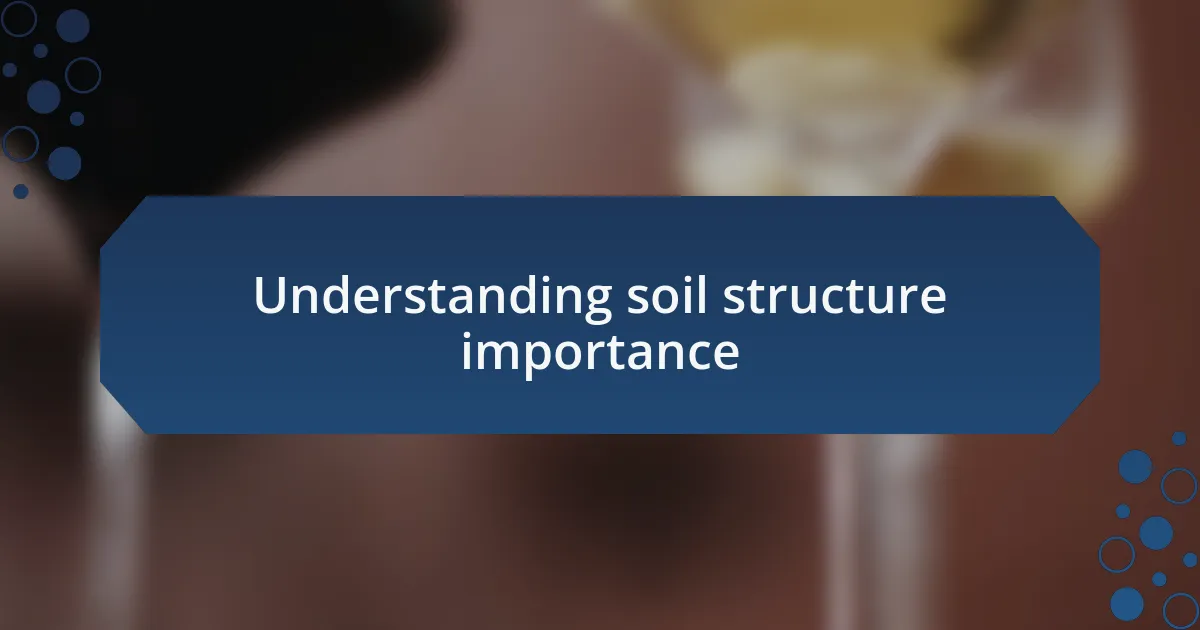
Understanding soil structure importance
Soil structure is like the foundation of a healthy vineyard; it directly impacts water retention, root growth, and nutrient availability. I’ve witnessed how well-structured soil can create thriving vines, transforming a simple patch of land into a lush paradise. When I think back to one particularly dry season, my vineyard’s crop flourished due to the rich, crumbly soil that held moisture beautifully—can you imagine the difference that made?
Good soil structure isn’t just about physical properties; it also fosters a vibrant ecosystem. I’ve dug my hands into the earth and felt the bustling life within—earthworms, beneficial fungi, and countless microorganisms working in harmony. This living soil not only nurtures the plants but also enhances flavor profiles in the wine, making the connection between soil health and wine quality undeniable.
Have you ever considered how soil structure contributes to the resilience of a vineyard? With the right structure, the land can better withstand extreme weather events, which is invaluable in today’s changing climate. I’ve watched as vineyards with poor soil structure struggled during floods, while others thrived because their strong, well-aerated soil absorbed the excess water like a sponge. It’s a striking reminder of soil’s crucial role in organic wine production.
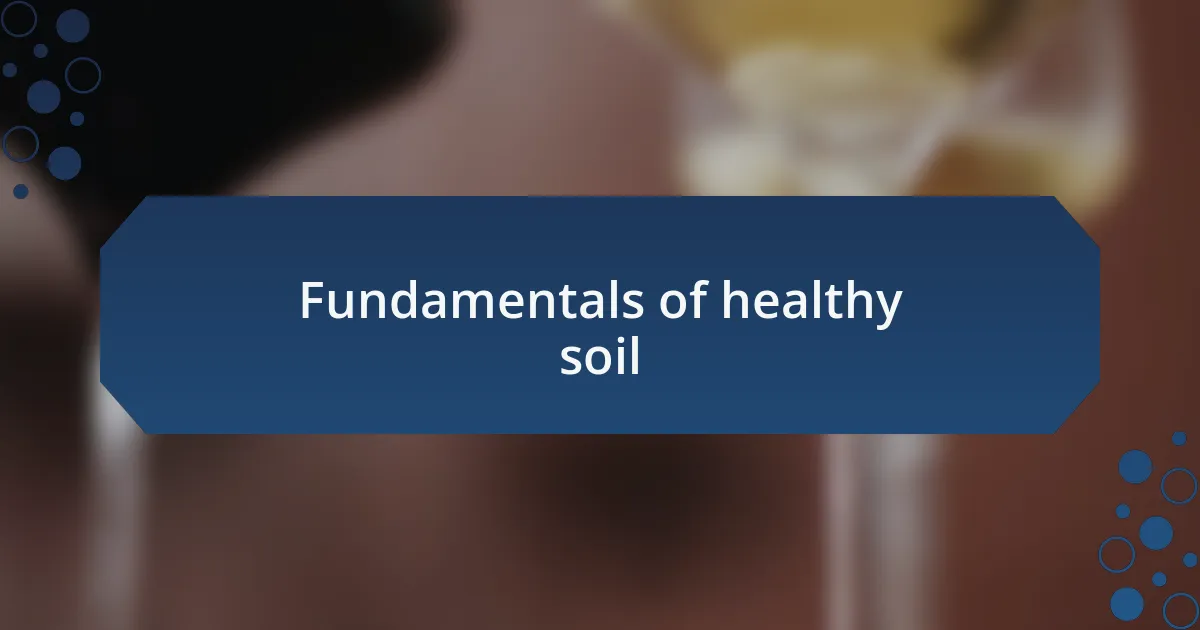
Fundamentals of healthy soil
Healthy soil is fundamentally a living entity, teeming with diverse organisms that contribute to its fertility. I remember the first time I observed microbial life in action while inspecting a compost tea I’ve brewed; it was astonishing to see how these tiny beings play such a large role in nutrient cycling. Have you ever noticed how the best vineyards often have that rich, earthy smell? That scent reveals the beneficial life hidden beneath the surface, essential for robust plant growth.
The balance of soil minerals, organic matter, and air spaces directly influences soil structure. I’ve spent countless hours amending my vineyard soil, learning firsthand that the addition of compost can dramatically alter its composition and health. Isn’t it fascinating how something as simple as organic matter can enhance the soil’s capacity to hold both water and nutrients, creating a more resilient ecosystem?
A crucial component of healthy soil is its ability to retain and release moisture. I recall a particularly rainy season when my vineyard’s proper drainage made all the difference; the soil embraced the water yet avoided saturation. Have you ever thought about how this moisture management could mitigate the effects of drought or heavy rains in your own garden? Understanding and nurturing this aspect of soil structure can significantly improve vineyard health and productivity.
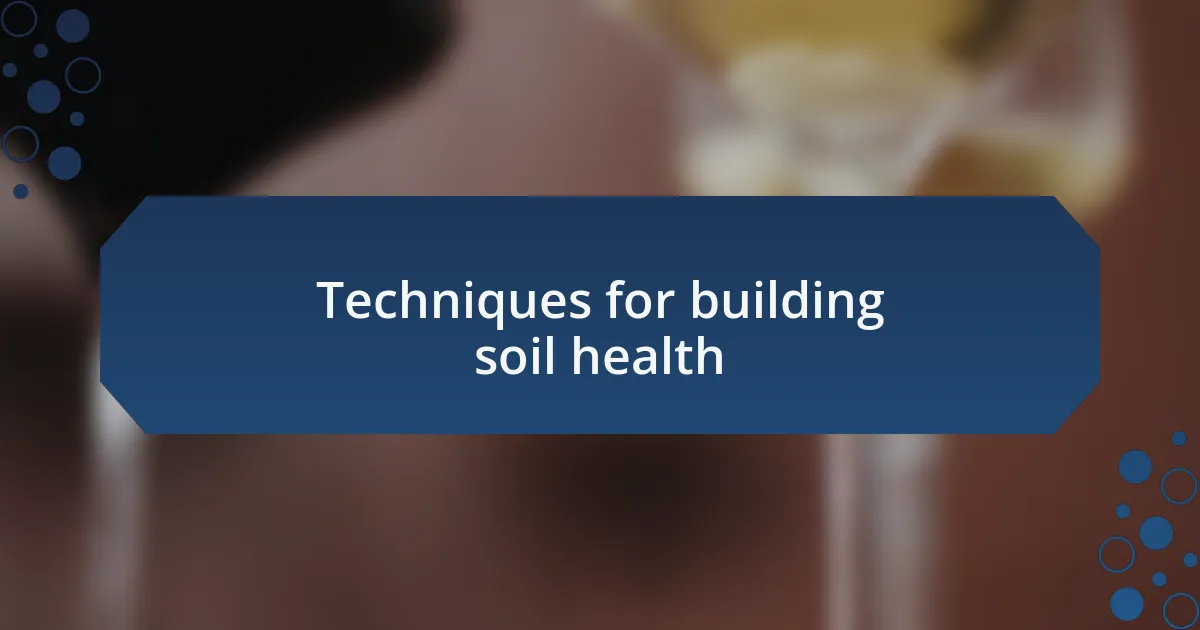
Techniques for building soil health
Building soil health requires a thoughtful combination of techniques that reconcile both nature and our agricultural practices. I’ve found that cover cropping is one of the most effective methods. When I started planting legumes between my vineyard rows, I was amazed at how they not only fixed nitrogen in the soil but also improved its structure. Have you ever thought about how a simple plant can work so hard to enrich the soil for future crops?
Adding organic amendments, like well-rotted manure or compost, can also transform soil vitality. I still remember the first time I spread a layer of compost over my vineyard; it felt like giving my plants a nourishing boost. The joy of watching them thrive afterward made it clear to me that these natural additions are not just beneficial; they’re essential for a sustainable ecosystem.
Incorporating crop rotation is another strategy I swear by. I usually alternate between different grape varieties and other crops, which keeps pests at bay and promotes a more balanced nutrient profile. Have you ever tried varying your planting schedule? It not only keeps the soil active but also adds layers of complexity that encourage resilience. This technique really reflects the beauty of nature’s cycles, and witnessing the positive changes is incredibly satisfying.
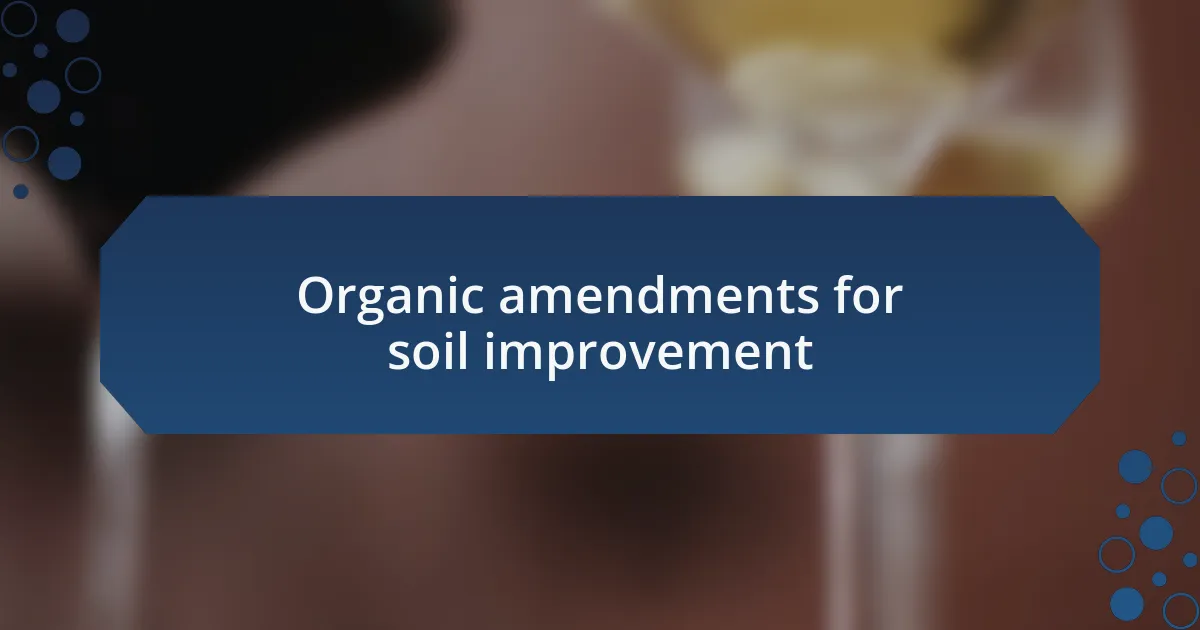
Organic amendments for soil improvement
Using organic amendments for soil improvement is a fascinating journey that has transformed my vineyard over the years. When I first experimented with compost tea, I was skeptical. Yet, the immediate boost in microbial activity was astounding and made me realize how vital these organic inputs are in reviving the soil ecosystem. Have you ever just sat back and observed how nature responds when we nurture it with simple, natural solutions?
One of the organic amendments that truly made a difference for me was biochar. I remember the first time I mixed it into my soil—what a game-changer! It not only enhanced nutrient retention but also acted like a sponge to hold moisture. Seeing how my vines responded to this amendment, thriving even in dry spells, convinced me that biochar is invaluable in our organic wine production. What if, instead of solely relying on chemical fertilizers, we tapped into the innate power of organic materials?
Another incredible organic amendment I’ve enjoyed using is green manure—plants that are grown specifically to be tilled back into the soil. I recall planting buckwheat between my vineyard rows and later turning it under. The fresh scent and vibrant growth were signs of health and vitality. Knowing that these plants would enrich the soil and promote better tilth felt rewarding. How often do we take a moment to appreciate the dynamic relationship between plants and soil? It’s these organic practices that truly deepen that connection and foster thriving vineyards.
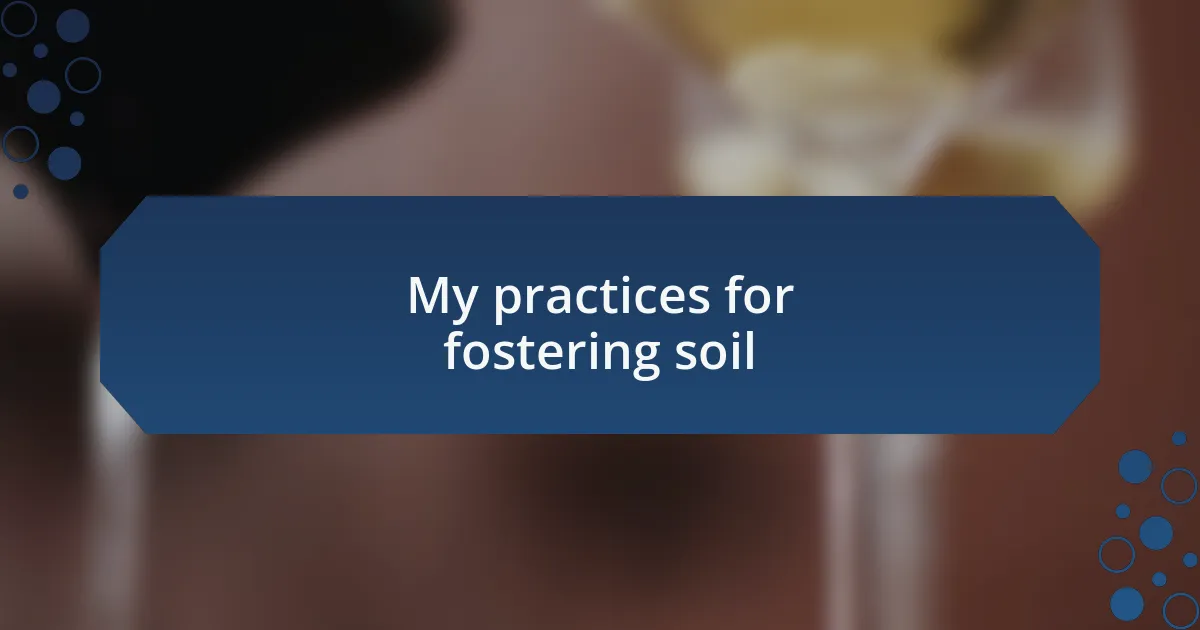
My practices for fostering soil
One of my go-to practices for fostering healthy soil is rotating cover crops. I vividly remember the first year I planted clover as a cover crop. The vibrant green carpet that grew during the off-season was not just visually pleasing; it also helped fix nitrogen in the soil, adding essential nutrients for my vines. Have you ever thought about how such small changes can lead to significant shifts in soil health?
Another approach I’ve found incredibly effective is incorporating organic mulches. I learned the importance of this when I stumbled upon a pile of wood chips from a local lumber mill. Spreading them around my vines not only conserved moisture but also created a home for beneficial organisms. Witnessing the soil’s evolution as it became rich and crumbly was a rewarding experience. It’s astonishing how a simple layer of organic matter can make such a profound impact.
Lastly, I’ve embraced minimal tillage techniques. Initially, I worried that reducing soil disturbance might hinder root growth. However, I quickly discovered that this practice maintained soil structure and improved water infiltration. Seeing my vines flourish with a more settled soil led me to appreciate the beauty of working alongside nature. What if, instead of fearfully disturbing the soil, we allowed it to breathe and thrive on its own?
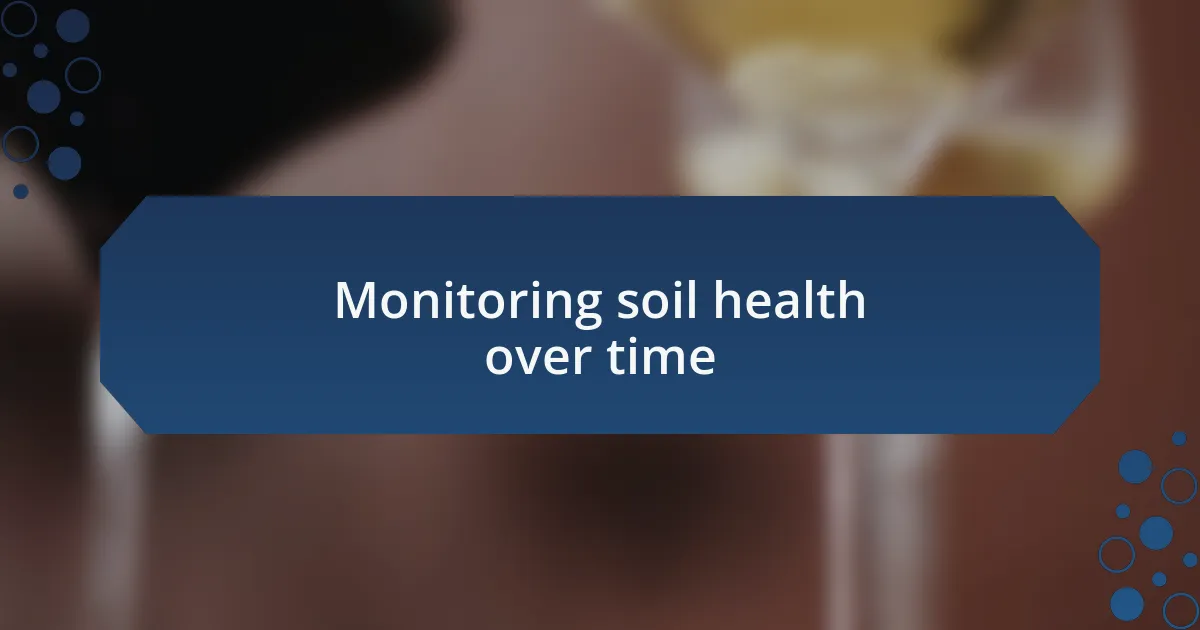
Monitoring soil health over time
Monitoring soil health over time is a practice that has profoundly shaped my approach to organic wine production. I’ve developed a habit of regularly taking soil samples to analyze nutrient levels and microbial activity. The first time I sent a sample to the lab, I was excited and a little anxious. Watching the results come back was like checking the pulse of my vineyard. It made me realize just how vital it is to keep a close eye on what’s happening beneath the surface.
In addition to testing, I’ve found that keeping a detailed log of changes in soil composition, moisture levels, and even the growth patterns of my cover crops provides invaluable insights. One year, I noticed a significant drop in nitrogen levels that coincided with a particularly dry summer. Jotting down these observations has not only deepened my understanding but also helped me make timely adjustments. Isn’t it fascinating how a simple notebook can become a powerful tool in nurturing healthier vines?
Lastly, I often engage with the rhythm of nature, observing how my soil reacts to different weather patterns over the seasons. Each year feels like its own chapter, and I’ve come to appreciate the dynamic relationship between soil and climate. I vividly recall a late spring rain that transformed my vineyard into a lush haven. Those moments of connection remind me that soil health isn’t a static goal; it’s a living, breathing entity that evolves over time. What discoveries await you in the journey of understanding soil health?

Lessons learned from my experience
Each experience I’ve had in the vineyard has taught me something unique about fostering healthy soil structures. For instance, after a particularly challenging harvest, I experimented with incorporating compost from my kitchen scraps into my vineyard. The noticeable improvement in soil texture and fertility was incredibly rewarding. It made me wonder how often we overlook simple solutions right in our own backyards.
I’ve also learned the importance of patience in the process. I remember anxious days waiting for the results of my organic matter tests, wondering if my techniques were right. Slowly, I realized that soil health doesn’t change overnight; it takes time, much like growing a fine wine. How often do we rush results without considering the gradual transformation taking place beneath our feet?
One revelation that stands out is the role of biodiversity. I once planted a mix of wildflowers in my vineyard as a way to attract beneficial insects. Watching those blossoms flourish not only filled me with joy but also invited life into my soil ecosystem. It made me ask: how can we nurture more connections within our farming practices? Embracing diversity in my vineyard has opened doors to healthier soil and, ultimately, richer wines.